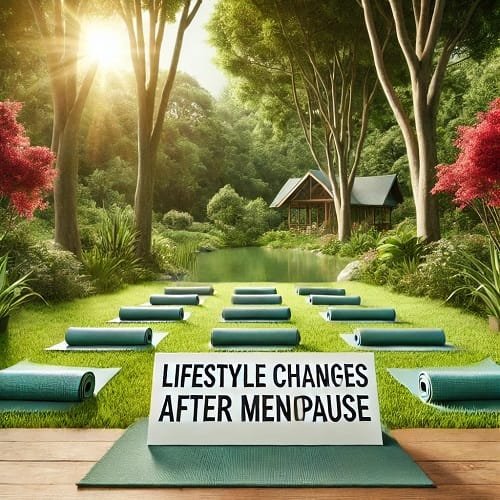I. Introduction
Menstrual cramps after menopause are a common yet often misunderstood issue that many women face. Despite the cessation of periods, some women experience discomfort similar to menstrual cramps, which can range from mild to severe. These cramps may seem surprising to those who thought they had left this part of their reproductive life behind. The occurrence of post-menopausal cramps can be unsettling, but understanding the underlying causes and knowing how to manage them is crucial for maintaining comfort and well-being during this stage of life.
The issue of menstrual cramps after menopause affects a significant number of women, even years after their last period. Understanding the causes of cramps after menopause, such as hormonal changes or underlying health conditions, can help demystify the symptoms and lead to more effective solutions. The importance of addressing these cramps cannot be overstated, as they can impact daily activities, emotional health, and overall quality of life. Whether through menopause relief treatments, lifestyle changes, or medical interventions, there are options available to help manage this condition and improve the lives of women dealing with it.
Table of Contents
II. What Are Menstrual Cramps After Menopause?

Menstrual cramps after menopause refer to the painful, uterine-like discomfort that some women experience even after they’ve stopped menstruating. Although periods end during menopause, it’s not uncommon for women to continue feeling pain after menopause that mirrors menstrual-like cramps after menopause. These cramps can occur anywhere from a few months to years after the final menstrual period, often causing confusion and concern. The pain typically presents as dull or sharp discomfort in the lower abdomen, pelvis, or lower back, similar to the cramps that many women experience during their monthly cycles.
The causes of menstrual cramps after menopause differ significantly from those experienced during regular menstruation. In a post-menopausal woman, the cramps may not be directly tied to menstruation but could be the result of several factors, including hormonal imbalances or underlying health conditions. One common cause of uterine cramps after menopause is endometrial tissue that remains in the uterus, continuing to cause discomfort even after menopause.
Additionally, post-menopausal symptoms like uterine cramps after menopause can also be caused by pelvic conditions such as fibroids, ovarian cysts, or even an inflamed pelvic area. These issues, which are often overlooked or attributed to aging, can contribute to the persistence of menstrual cramps after menopause. Hormonal fluctuations, particularly a decrease in estrogen levels, can also lead to pelvic muscle contractions, which may be mistaken for menstrual cramps. Thus, while the menstrual cycle has ended, the physical changes within the body can still trigger symptoms that closely resemble menstrual cramps.
Understanding why these cramps happen is essential for effective management. While the causes can vary from one woman to another, identifying the root of the discomfort is key to finding relief.
III. Common Causes of Menstrual Cramps After Menopause

Menstrual cramps after menopause can have various underlying causes that are often connected to hormonal shifts and other pelvic health changes. Understanding these causes can help women better manage and alleviate the discomfort associated with this post-menopausal issue. Let’s explore some of the most common reasons why women might experience menstrual cramps after menopause.
Hormonal Imbalances
One of the most significant contributors to menstrual cramps after menopause is hormonal imbalance, particularly fluctuations in estrogen and progesterone levels. During menopause, the body’s production of estrogen and progesterone declines, which can affect the delicate balance required for smooth muscle function in the pelvic region. Even though menstruation ceases, residual hormonal activity can still trigger pelvic inflammation and muscle contractions, leading to cramps similar to those experienced during the menstrual cycle. These hormonal changes after menopause can cause the pelvic muscles to tighten and contract, resulting in uterine cramps after menopause.
Endometriosis After Menopause
Another possible cause of menstrual cramps after menopause is the presence of endometrial tissue outside the uterus, a condition known as endometriosis. In some women, endometriosis persists even after menopause due to the fact that certain types of endometrial tissue are hormone-sensitive. This means that despite the reduced estrogen levels after menopause, these tissue remnants can still respond to hormone fluctuations, causing inflammation and pain. The resulting cramps are often sharp and persistent, mimicking menstrual-like cramps after menopause.
Fibroids and Ovarian Cysts
Fibroids after menopause are another common cause of pelvic pain and cramping. These benign tumors, which develop in the walls of the uterus, may shrink after menopause, but in some cases, they continue to cause symptoms such as bloating, discomfort, and menstrual cramps after menopause. Similarly, ovarian cysts can persist or develop after menopause, leading to pain or cramping sensations in the lower abdomen. Both of these conditions can create a feeling of pressure or fullness in the pelvic area, resulting in discomfort that mimics pre-menopausal cramps.
Other Health Conditions
Finally, conditions like pelvic inflammation and infections can also contribute to menstrual cramps after menopause. Inflammation in the pelvic organs, often due to infections or other underlying conditions, can cause the muscles and tissues in the pelvis to become irritated, resulting in cramping and discomfort. These conditions can be subtle and may not always be immediately recognized, but they can be a significant source of pain for many post-menopausal women.
In conclusion, menstrual cramps after menopause are not just a result of hormonal changes but can also be linked to a variety of pelvic health conditions. Identifying the specific cause is essential for effective treatment and relief.
IV. Symptoms of Menstrual Cramps After Menopause

Menstrual cramps after menopause can present with a variety of symptoms that vary from woman to woman. The physical symptoms can often resemble those of pre-menopausal cramps, but they occur despite the cessation of periods. It’s important to understand these symptoms to better manage the discomfort and know when further evaluation is necessary.
Physical Symptoms
The most common symptom of menstrual cramps after menopause is pelvic pain, which may be localized to the lower abdomen or lower back. Women may experience a dull, aching pain or sharp, cramp-like sensations that can fluctuate in intensity. Some may also experience bloating or a feeling of fullness in the lower abdomen. These sensations are often mistaken for the usual cramps in menopause, but they may persist beyond the expected timeframe of post-menopausal changes. It’s also possible to experience discomfort during or after intercourse, as the pelvic tissues may be more sensitive due to hormonal fluctuations.
In addition to lower abdominal pain, some women may feel tightness or discomfort in the lower back, especially when engaging in physical activity or prolonged sitting. This pain can sometimes radiate from the pelvic region and become chronic if left unaddressed. Post-menopausal pain can also affect other areas of the body, leading to stiffness or discomfort in the hips and thighs.
When to Seek Medical Attention
While menstrual cramps after menopause can be common, there are times when they might indicate a more serious underlying condition. If the cramps are severe, persist for an extended period, or are accompanied by other symptoms like heavy bleeding or painful intercourse, it’s important to seek medical attention. Conditions like fibroids, ovarian cysts, or endometriosis after menopause can cause severe pain and require professional evaluation. Early diagnosis is key to managing these conditions and preventing further complications.
ALSO READ
Menopause and Anger Towards Husband: Causes & Coping Tips
How to Treat Menopause Back Pain: Effective Solutions & Tips
Can Menopause Cause Nausea? What Women Should Know
POTS and Endometriosis: 7 Facts to Know
V. Effective Solutions for Menstrual Cramps After Menopause

Menstrual cramps after menopause can significantly affect a woman’s quality of life. Fortunately, there are several menopause treatments available to help manage and reduce these cramps, ranging from medical interventions to holistic approaches and lifestyle changes. Let’s explore the most effective solutions for dealing with menstrual cramps after menopause.
Medical Treatments
One of the primary treatments for menstrual cramps after menopause is hormone therapy. Hormonal fluctuations are a key contributor to cramps, and hormone replacement therapy (HRT) can help restore balance, especially in women whose hormonal levels are still fluctuating post-menopause. HRT can regulate estrogen and progesterone levels, potentially reducing the discomfort caused by menstrual cramps after menopause. Women who experience severe symptoms may also benefit from other medications prescribed by a doctor, such as birth control pills or progestin therapy, to manage these cramps effectively.
While hormone therapy has been widely used to treat various menopausal symptoms, it’s essential to consult a healthcare provider to weigh the risks and benefits, particularly since hormone therapy can come with side effects for some women, including an increased risk of certain health conditions.
Over-the-Counter Pain Relief
For many women, over-the-counter pain relief can provide effective relief from menstrual cramps after menopause. Medications such as ibuprofen (Advil) or acetaminophen (Tylenol) can help alleviate the pain associated with cramping. These medications work by reducing inflammation and providing pain relief, making them a useful option for managing the discomfort caused by pelvic pain or lower abdominal pain. However, it’s essential to follow the recommended dosages and consult a doctor if the pain persists or worsens.
Alternative Treatments
In addition to conventional medications, many women are turning to alternative treatments for menopause to manage menstrual cramps after menopause. Acupuncture is one such option that has been shown to reduce pain by stimulating certain points on the body that promote healing and relaxation. It can help with pelvic inflammation and reduce cramping by improving the flow of energy in the body.
Herbal remedies and supplements are also gaining popularity for managing cramps naturally. Herbs like black cohosh, chamomile, and ginger have anti-inflammatory properties that may help reduce the intensity of cramps. Additionally, omega-3 fatty acids and vitamin E have been shown to support hormonal balance and alleviate cramps, making them a good option for women seeking menopause relief. Before starting any new supplement or herbal regimen, it’s important to consult with a healthcare provider to ensure that it’s safe and effective for your unique needs.
Lifestyle Changes
Sometimes, the best way to manage menstrual cramps after menopause is through lifestyle changes that improve overall health and reduce stress on the body. Regular exercise has been shown to reduce the frequency and intensity of cramps by improving circulation and strengthening the pelvic muscles. Even simple activities like walking, yoga, or swimming can have a positive effect on reducing pelvic pain and improving overall wellness.
Adopting a healthy diet rich in fruits, vegetables, whole grains, and lean proteins can also support hormone balance and reduce the likelihood of cramps. Reducing the intake of processed foods and sugars can help control inflammation, which may contribute to menstrual-like cramps after menopause. Additionally, staying hydrated and managing your weight can play a significant role in alleviating symptoms.
Stress management techniques such as meditation, mindfulness, and deep-breathing exercises can also be beneficial in reducing cramps. High stress levels can exacerbate pelvic inflammation and contribute to hormonal imbalances, so finding ways to relax and unwind is crucial for long-term relief.
Conclusion
Managing menstrual cramps after menopause requires a multifaceted approach. From hormone therapy to alternative treatments and lifestyle changes, women have several options to explore when seeking relief. By consulting with a healthcare provider and tailoring treatments to individual needs, it’s possible to find effective solutions that improve both comfort and quality of life. Whether through over-the-counter pain relief, holistic therapies, or simple lifestyle adjustments, the key is to take proactive steps towards managing the discomfort and enhancing overall well-being.
VI. Preventing Menstrual Cramps After Menopause

While menstrual cramps after menopause can be distressing, the good news is that there are several steps you can take to prevent cramps after menopause and reduce their frequency and severity. By incorporating certain lifestyle habits and being proactive about your healthcare, you can significantly minimize the discomfort associated with post-menopausal cramps.
Preventative Measures
One of the most effective ways to prevent cramps after menopause is through regular exercise. Engaging in physical activity helps improve circulation, strengthen muscles, and reduce pelvic inflammation, all of which can alleviate cramps. Whether it’s walking, swimming, or practicing yoga, staying active has a positive effect on overall health and can be particularly beneficial in reducing lower abdominal pain and pelvic pain. Exercise can also boost endorphin levels, which act as natural pain relievers, further helping to manage menstrual-like cramps after menopause.
A balanced diet is another crucial aspect of managing menopause symptoms and preventing menstrual cramps after menopause. Eating a diet rich in anti-inflammatory foods like fruits, vegetables, whole grains, and healthy fats can help regulate hormones and reduce inflammation, which is often linked to cramping. Avoiding excessive alcohol, caffeine, and processed foods can also help maintain hormonal balance and prevent pelvic inflammation. Staying hydrated is equally important, as dehydration can exacerbate cramps and discomfort.
Managing stress is essential for preventing menstrual cramps after menopause. Stress can lead to hormonal fluctuations and muscle tension, which may contribute to the intensity of cramps. Incorporating relaxation techniques such as meditation, deep breathing exercises, or mindfulness can help lower stress levels, making it easier to manage menstrual cramps.
Proactive Healthcare
In addition to lifestyle changes, proactive healthcare plays a vital role in preventing and managing menstrual cramps after menopause. Regular check-ups with your healthcare provider are essential to monitor hormonal changes after menopause and address any underlying health concerns. Hormonal imbalances, fibroids, or ovarian cysts can contribute to pelvic pain or post-menopausal cramps, so early detection and management can prevent these issues from worsening.
By staying on top of your health and making informed lifestyle choices, you can significantly reduce the likelihood of experiencing menstrual cramps after menopause and lead a more comfortable post-menopausal life.
VII. Frequently Asked Questions (FAQ)
What causes menstrual cramps after menopause?
Menstrual cramps after menopause can occur due to several factors, most commonly related to hormonal imbalances. As estrogen and progesterone levels fluctuate during the transition to menopause, these changes can cause the uterus to contract, leading to cramps. Other factors include conditions like fibroids after menopause, endometriosis, or ovarian cysts, all of which can persist and cause pelvic pain or cramps in menopause. Additionally, pelvic inflammation and certain medications can contribute to these symptoms.
Is it normal to experience cramps after menopause?
While experiencing menopausal cramps after menopause is not typical, it is not uncommon either. In some cases, cramps after menopause may be due to hormonal fluctuations or uterine conditions that continue to affect a woman’s body even after menstruation stops. However, if cramps are severe or persistent, it is important to seek medical advice, as it could be a sign of an underlying condition such as fibroids, endometriosis, or other health issues. It’s crucial to differentiate between normal post-menopausal discomfort and symptoms that require medical attention.
How can I relieve menstrual cramps after menopause?
There are several ways to relieve menstrual cramps after menopause. Hormone replacement therapy (HRT) can help balance estrogen and progesterone levels and reduce cramps caused by hormonal fluctuations. Over-the-counter pain relief, such as ibuprofen or acetaminophen, can manage discomfort. Additionally, lifestyle changes like regular exercise, maintaining a balanced diet, and practicing stress-relief techniques can help manage menopausal cramps. Alternative treatments, such as acupuncture or herbal remedies, are also gaining popularity as menstrual cramps solutions.
VIII. Conclusion
In conclusion, menstrual cramps after menopause are a real and sometimes distressing issue that many women face. However, with a clear understanding of the causes of cramps after menopause and the wide array of menstrual cramps solutions available, women can confidently manage and reduce discomfort. Whether through medical treatments, lifestyle adjustments, or alternative therapies, relief is achievable. If you’re struggling with these symptoms, it’s crucial to consult with a healthcare provider to ensure that your health after menopause is on track and that you’re receiving the best possible care. With the right approach, you can navigate the post-menopausal phase with greater comfort and confidence.






